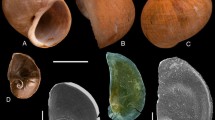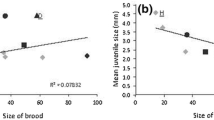Abstract
Bathydoris hodgsoni and Doris kerguelenensis are two of the largest Antarctic nudibranchs. They are both common circumpolar species with broad bathymetric distributions, although B. hodgsoni is restricted to deep waters in the Antarctic high latitude. Egg masses and juveniles of these species were collected over multiple years (1998–2012) in the eastern Weddell Sea and the South Shetland Islands, and here new data are provided about egg mass characteristics and ontogeny using histological techniques. The egg mass of B. hodgsoni has a maximum length of 12.4 cm with one or two egg capsules with a mean diameter of 4.9 cm. The capsules either contained non-developing eggs or ready-to-hatch juveniles up to 2.9 cm long. The egg mass of D. kerguelenensis is a semicircular ribbon-like structure including 1,500–2,400 oval capsules (~1.7 × 1.2 mm) containing various stages of development up to ready-to-hatch juveniles 2.5 mm in length. Based on their morphology and development in egg masses maintained in the laboratory, the embryonic period for B. hodgsoni is estimated to be up to 10 years, and for D. kerguelenensis 13 months. Thus, B. hodgsoni has the largest egg capsules and probably the largest hatchlings of any mollusc. Chemical analyses of D. kerguelenensis egg masses showed no trace of terpenoid acylglycerols, although these compounds were present in field-collected juveniles and adults. None of four sponges that likely serve as food for D. kerguelenensis had the glycerides, or their precursors, found in the nudibranch.





Similar content being viewed by others
References
Animal Base Project Group (2016) 2005–2016 Animal Base. Early zoological literature online. World wide web electronic publication http://www.animalbase.uni-goettingen.de. Accessed 01 Dec 2016
Avila C, Iken K, Fontana A, Cimino G (2000) Chemical ecology of the Antarctic nudibranch Bathydoris hodgsoni Eliot, 1907: defensive role and origin of its natural products. J Exp Mar Bio Ecol 252:27–44
Avila C, Núñez-Pons L, Moles J (in press) From the tropics to the poles: chemical defensive strategies in sea slugs (Mollusca: Heterobranchia). In: Puglisi-Weening M, Becerro MA, Paul VJ (Eds) Chemical ecology: the ecological impacts of marine natural products. Taylor & Francis Group
Bergh R (1884) Report on the nudibranchiata. Chall Rep Zool 10:1–151
Blunt J, Copp BR, Keyzers R, Munro M, Prinsep M (2016) Marine natural products. Nat Prod Rep 33:382–431. doi:10.1039/C4NP00144C
Chaban EM (2016) New genus of opisthobranch molluscs Antarctophiline gen. nov. (Cephalaspidea: Philinoidea) from the cooperation sea, Antarctica. Ruthenica 26:49
Cimino G, Ghiselin MT (2009) Chemical defense and the evolution of opisthobranch gastropods. Proc Calif Acad Sci 60:175–422
Clark KB, Goetzfried A (1978) Zoogeographic influences on development patterns of North Atlantic Ascoglossa and Nudibranchia, with a discussion of factors affecting egg size and number. J Molluscan Stud 44:283–294
Clarke A (1992) Is there a latitudinal diversity cline in the sea? Trends Ecol Evol 7:286–287. doi:10.1016/0169-5347(92)90222-W
Clarke A (2003) Costs and consequences of evolutionary temperature adaptation. Trends Ecol Evol 18:573–581. doi:10.1016/j.tree.2003.08.007
Clarke A (2008) Antarctic marine benthic diversity: patterns and processes. J Exp Mar Bio Ecol 366:48–55
Clarke A, Aronson RB, Crame JA, Gili J-M, Blake DB (2004) Evolution and diversity of the benthic fauna of the Southern Ocean continental shelf. Antarct Sci 16:559–568
Cutignano A, Zhang W, Avila C, Cimino G, Fontana A (2011) Intrapopulation variability in the terpene metabolism of the Antarctic opisthobranch mollusc Austrodoris kerguelenensis. Eur J Org Chem 2011:5383–5389. doi:10.1002/ejoc.201100552
Dayton PK, Mordida BJ, Bacon F (1994) Polar marine communities. Am Zool 34:90–99
Diyabalanage T, Iken KB, McClintock JB, AmslerCD Baker BJ (2010) Palmadorins A-C, diterpene glycerides from the Antarctic nudibranch Austrodoris kerguelenensis. J Nat Prod 73:416–421. doi:10.1021/np900617m
Eliot C (1907) Mollusca IV Nudibranchiata. National Antarctic expedition 1901–1904. Nat Hist 2:1–28
Fontana A (2006) Biogenetic proposals and biosynthetic studies on secondary metabolites of marine molluscs. In: Cimino G, Gavagnin M (eds) Marine molecular biotechnology, series progress in molecular and subcellular biology, vol. Molluscs. Springer, Heidelberg, pp 303–332
Gavagnin M, Trivellone E, Castelluccio F, Cimino G (1995) Glyceryl ester of a new halimane diterpenoic acid from the skin of the Antarctic nudibranch Austrodoris kerguelenensis. Tetrahedron Lett 36:7319–7322
Gavagnin M, Castelluccio F, Cimino G (1999a) Austrodorin-A and -B: first tricyclic diterpenoid 2′-monoglyceryl esters from an Antarctic nudibranch. Tetrahedron Lett 40:8471–8475
Gavagnin M, De Napoli A, Cimino G, Iken K, Avila C, García FJ (1999b) Absolute configuration of diterpenoid diacylglycerols from the Antarctic nudibranch Austrodoris kerguelenensis. Tetrahedron 10:2647–2650. doi:10.1016/S0957-4166(99)00273-6
Gavagnin M, Carbone M, Mollo E, Cimino G (2003a) Austrodoral and austrodoric acid: nor-sesquiterpenes with a new carbon skeleton from the Antarctic nudibranch Austrodoris kerguelenensis. Tetrahedron Lett 44:1495–1498
Gavagnin M, Carbone M, Mollo E, Cimino G (2003b) Further chemical studies on the Antarctic nudibranch Austrodoris kerguelenensis: new terpenoid acylglycerols and revision of the previous stereochemistry. Tetrahedron 59:5579–5583. doi:10.1016/S0040-4020(03)00775-0
Gibson RAY, Thompson TE, Robilliard GA (1970) Structure of the spawn of an Antarctic dorid nudibranch Austrodoris macmurdensis Odhner. Proc Malacol Soc London 39:221–226
Hain S (1989) Beiträge zur Biologie der beschalten Mollusken (Kl. Bremen University, Gastropoda and Bivalvia) des Weddellmeeres, Antarktis
Hain S (1992) Maintenance and culture of living benthic molluscs from high Antarctic shelf areas. Aquac Fish Manag 23:1–11
Hain S, Arnaud PM (1992) Notes on the reproduction of high-Antarctic molluscs from the Weddell Sea. Polar Biol 12:303–312
Iken K, Avila C, Ciavatta ML, Fontana A, Cimino G (1998) Hodgsonal, a new drimane sesquiterpene from the mantle of the Antarctic nudibranch Bathydoris hodgsoni. Tetrahedron Lett 39:5635–5638. doi:10.1016/S0040-4039(98)01095-8
Iken K, Avila C, Fontana A, Gavagnin M (2002) Chemical ecology and origin of defensive compounds in the Antarctic nudibranch Austrodoris kerguelenensis (Opisthobranchia: Gastropoda). Mar Biol 141:101–109. doi:10.1007/s00227-002-0816-7
Klussmann-Kolb A, Wägele H (2001) On the fine structure of opisthobranch egg masses (Mollusca, Gastropoda). Zool Anz 240:101–118
Levin LA, Bridges TS (1995) Pattern and diversity in reproduction and development. In: McEdward L (ed) Ecology of marine invertebrate larvae. CRC Press, Florida
Martynov AV (2011) From “Tree-Thinking” to “Cycle-Thinking”: ontogenetic systematics of nudibranch molluscs. Thalassas 27:193–224
Maschek JA, Mevers E, Diyabalanage T, Chen L, Ren Y, McClintock JB, Amsler CD, Wu J, Baker BJ (2012) Palmadorin chemodiversity from the Antarctic nudibranch Austrodoris kerguelenensis and inhibition of Jak2/STAT5-dependent HEL leukemia cells. Tetrahedron 68:9095–9104. doi:10.1016/j.tet.2012.08.045
McDonald GR, Nybakken JW (1997) A list of the worldwide food habits of nudibranchs. I. Introduction and the suborder Arminacea. Veliger 40:1–764
Moles J, Wägele H, Cutignano A, Fontana A, Avila C (2016) Distribution of granuloside in the Antarctic nudibranch Charcotia granulosa (Gastropoda: Heterobranchia: Charcotiidae). Mar Biol 163:1–11
Moran AL, Woods HA (2012) Why might they be giants? Towards an understanding of polar gigantism. J Exp Biol 215:1995–2002
Palmer AR (1994) Temperature sensitivity, rate of development, and time to maturity: geographic variation in laboratory-reared Nucella and a cross-phyletic overview. In: Wilson WH (ed) Reproduction and development of marine invertebrates. Johns Hopkins University Press, Baltimore, pp 177–194
Pearse JS, McClintock JB, Bosch I (1991) Reproduction of Antarctic benthic marine invertebrates: tempos, modes, and timing. Am Zool 31:65–80
Peck LS, Clarke A, Chapman AL (2006) Metabolism and development of pelagic larvae of Antarctic gastropods with mixed reproductive strategies. Mar Ecol Prog Ser 318:213–220. doi:10.3354/meps318213
Peck LS, Powell DK, Tyler PA (2007) Very slow development in two Antarctic bivalve molluscs, the infaunal clam Laternula elliptica and the scallop Adamussium colbecki. Mar Biol 150:1191–1197. doi:10.1007/s00227-006-0428-8
Rivas LR (1964) A reinterpretation of the concepts “sympatric” and “allopatric” with proposal of the additional terms “syntopic” and “allotopic”. Syst Biol 13:42–43
Ros J (1981) Desarrollo y estrategias bionómicas en los Opistobranquios. Oecologia Aquat 5:147–183
Saunders WB (1984) Nautilus growth and longevity: evidence from marked and recaptured animals. Science 224:990–992. doi:10.1126/science.224.4652.990
Schaefer K (1996) Review of data on cephalaspid reproduction, with special reference to the genus Haminaea (Gastropoda, Opisthobranchia). Ophelia 45:17–37
Seager JR (1979) Reproductive biology of the Antarctic opistobranch Philine gibba Strebel. J Exp Mar Bio Ecol 41:51–74
Thompson TE (1967) Direct development in a nudibranch, Cadlina laevis, with a discussion of developmental processes in opisthobranchia. J Mar Biol Assoc UK 47:1–22
Thompson TE, Jarman GM (1986) Factors bearing upon egg size and embryonic period in opisthobranch molluscs. Bol Zool Univ São Paulo 10:9–18
Thorson G (1936) The larval development, growth, and metabolism of arctic marine bottom invertebrates compared with those of other seas. Medd Grönl 100:1–155
Todd CD, Doyle RW (1981) Reproductive strategies of marine benthic invertebrates: a settlement-timing hypothesis. Mar Ecol Prog Ser 4:75–83. doi:10.3354/meps004075
Ungvari Z, Csiszar A, Sosnowska D, Philipp EE, Campbell CM, McQuary PR, Chow TT, Coelho M, Didier ES, Gelino S, Holmbeck MA, Kim I, Levy E, Sonntag WE, Whitby PW, Austad SN (2012) Testing predictions of the oxidative stress hypothesis of aging using a novel invertebrate model of longevity: the giant clam (Tridacna derasa). J Gerontol A Biol Sci Med Sci. doi:10.1093/gerona/gls159
Valdés Á (2002) Phylogenetic systematics of “Bathydoris” s.l. Bergh, 1884 (Mollusca, Nudibranchia), with the description of a new species from New Caledonian deep waters. Can J Zool 80:1084–1099. doi:10.1139/Z02-085
Wägele H (1989a) On the morphology and ultrastucture of some egg-clutches of Antarctic nudibranchs (Gastropoda). Zool Anz 222:225–243
Wägele H (1989b) Diet of some Antarctic nudibranchs (Gastropoda, Opisthobranchia, Nudibranchia). Mar Biol 100:439–441
Wägele H (1989c) A revision of the Antarctic species of Bathydoris Bergh, 1884 and comparison with other known Bathydoris (Opisthobranchia, Nudibranchia). J Molluscan Stud 55:343–364
Wägele H (1996) On egg clutches of some Antarctic Opisthobranchia. Molluscan Reprod Malacol Rev Suppl. 6:21–30
Wägele H (1997) Histological investigation of some organs and specialised cellular structures in Opisthobranchia (Gastropoda) with the potential to yield phylogenetically significant characters. Zool Anz 236:119–131
Wilson NG, Schrödl M, Halanych KM (2009) Ocean barriers and glaciation: evidence for explosive radiation of mitochondrial lineages in the Antarctic sea slug Doris kerguelenensis (Mollusca, Nudibranchia). Mol Ecol 18:965–984
Wilson NG, Maschek JA, Baker BJ (2013) A species flock driven by predation? Secondary metabolites support diversification of slugs in Antarctica. PLoS One 8:e80277. doi:10.1371/journal.pone.0080277
Wray GA, Raff RA (1991) The evolution of developmental strategy in marine invertebrates. Trends Ecol Evol 6:45–50. doi:10.1016/0169-5347(91)90121-D
Acknowledgements
We thank Y. Grzymbowski, L. Núñez-Pons, C. Debenham, M. Lavaleye, M. Rauschert, U. Jacobs, K. Beyer, T. Brey, W. Arntz, and the crew of the RV Polarstern for their help during sampling and rearing of the nudibranchs. Thanks are due to J. Cristobo, J. Vázquez, and the crew of BIO Las Palmas for their support while diving at Livingston Is. Funding was provided by the Spanish Government through the ECOQUIM (REN2003-00545, REN2002-12006E ANT, CGL2004-03356/ANT), ACTIQUIM (CGL2007-65453, CTM2010-17415/ANT), and DISTANTCOM (CTM2013-42667/ANT) projects. J. Moles was supported by a PhD grant from the Spanish Government (MEC; BES-2011-045325). This work is part of the AntEco (State of the Antarctic Ecosystem) Scientific Research Programme.
Author information
Authors and Affiliations
Corresponding author
Ethics declarations
Funding
This study was funded by the Spanish Government through the ECOQUIM (REN2003-00545, REN2002-12006E ANT, CGL2004-03356/ANT), ACTIQUIM (CGL2007-65453, CTM2010-17415/ANT), and DISTANTCOM (CTM2013-42667/ANT) Projects. J. Moles was supported by a PhD Grant of the Spanish Government (MEC; BES-2011-045325).
Conflict of interest
The authors declare that they have no conflict of interest.
Ethical approval
All applicable international, national, and/or institutional guidelines for the care and use of animals were followed.
Informed consent
“Informed consent was obtained from all individual participants included in the study.”
Additional information
Responsible Editor: J. Grassle.
Reviewed by undisclosed experts.
Electronic supplementary material
Below is the link to the electronic supplementary material.
Rights and permissions
About this article
Cite this article
Moles, J., Wägele, H., Cutignano, A. et al. Giant embryos and hatchlings of Antarctic nudibranchs (Mollusca: Gastropoda: Heterobranchia). Mar Biol 164, 114 (2017). https://doi.org/10.1007/s00227-017-3143-8
Received:
Accepted:
Published:
DOI: https://doi.org/10.1007/s00227-017-3143-8




